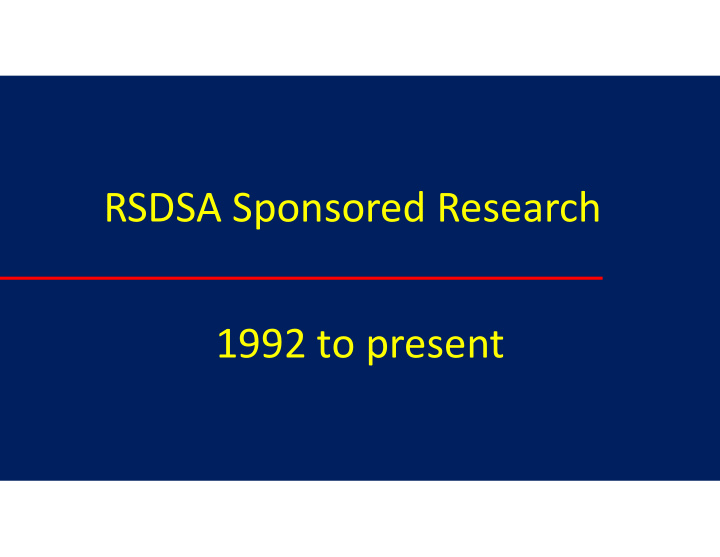



RSDSA Sponsored Research 1992 to present
RSDSA Sponsored Research ~$1,960,000
Mechanisms of Disease Diagnosis & Classification Treatment
Mechanism of Disease Early Efforts Model development Neural mechanism Adrenergic mechanisms More Recently Cytokines Autoimmune determinants Epigenetic determinants
Diagnosis & Classification Early Efforts Hypersensitivity and visceral pain Population studies Pain perception Major histocompatibility The Budapest Criteria Salivary Oxidation products
Diagnosis & Classification More Recently A Severity Score Defining “Recovery” A Core Data Set for clinical research Maternal mitrochondria
Treatment Early Efforts Surgical sympathectomy Transcranial stimulation Nitroglycerine Evidence ‐ based clinical practice guidelines
Treatment More Recently Low dose naltrexone Nitrous Oxide Induced sensory ‐ motor adaptation Ketamine infusion consensus guidelines
“20” Year Study of the Long Term Health Effects of CRPS Peter A. Moskovitz Denver, CO October 26, 2019
Why? Because people with CRPS feel that their disease is about more than the pain. Because other, “ un related” health problems aren’t un related.
How Come? My theory: CRPS is an immune mediated disease. Immune impairments have global effects.
Neuroinflammation (NI) A collection of diseases (this is just a few): Irritable Bowel Disease: NI of the intrinsic control of the gut Interstiticial Cystitis: NI of the bladder ALS and related degenerative diseases: NI of the motor apparatus Multiple Sclerosis: NI of the myelin apparatus (motor and sensory) Fibromyalgia: NI of the proprioceptive apparatus CRPS: NI of the nociceptive apparatus
Questions What is the incidence of adverse health events in people with CRPS over time? Are adverse health events related to the type or course of CRPS?
Study Design An Internet based survey An unselected sample of people with a diagnosis of CRPS A 9 ‐ part questionnaire, completed annually for 20 years
The Study Questionnaire Demographics 4 Review of systems check ‐ list 1 CRPS history 5 Medications Family history 6 Care utilization R Spread or Progression 7 Profile of mood states Remission 8 Pain disability index 2 Pain Experience 9 SF ‐ 36 3 McGill Pain Questionnaire
Data Management Professional Data Management Company Dedicated, secure research website Privacy assurance Safety protocols
The Study Team Peter Moskovitz, Washington, DC – Principle Investigator Kyoko Rice, Los Angeles, CA – Project Manager Jim Broatch, Milford, CT – Project Administrator Albert Farias, Los Angeles, CA ‐ Biostatistician
The Glitch There is no type nor sort of good idea that cannot be monetized to the benefit of the developer and for the exploitation of everyone else.
Who Responded? Mostly whom you’d expect: White women Does this imply a genetic predisposition to the disease – probably.
1802 Respondents Age in Group 521 480 329 194 148 77 53 Less than 18 18 ‐ 29 30 ‐ 39 40 ‐ 49 50 ‐ 59 60 and older No response
Where did CRPS start? Lower extremity more than upper. Only 5% non ‐ extremity CRPS Right (dominant?) side slightly > than left.
What “caused” it? CRPS Event by Injury vs Medical Procedure (n=1325) 13% Injury 48% 39% Surgery!
Who first suggested CRPS? Appropriately enough, 45% reported it was an Orthopaedic Surgeon. 3% reported that their own research suggested CRPS.
Can CRPS spread to other sites? 87% reported that their CRPS spread.
Does spread only occur early? 42% reported that their CRPS spread occurred more than a year after onset.
Does our cohort represent the population of people with CRPS? Probably not. Our respondents appear to have a more severe type or sort of CRPS.
Compared to “population ‐ based” cohorts of people with CRPS: Our respondents had: A lower incidence of remission more spread and reported less adequate pain control.
But there’s some good news. . Although the experience of pain didn’t change much over time, respondents reported improved Quality ‐ of ‐ life (SF ‐ 36).
The Take ‐ Home. . Coping with CRPS and adapting to the experience of chronic pain is possible. The stuff you learn here and from RSDSA works.
Recommend
More recommend